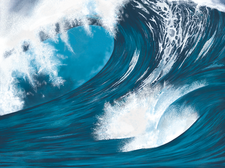Glimpse the future of the Linux desktop with the Wayland-based Hawaii
Catch a Wave

The Hawaii desktop relies on Qt Quick, supports Wayland, and comes with its own compositor. Thanks to the Maui Linux system, you can test Hawaii on a Live CD or on a VMware virtual machine.
The Linux classic desktop systems have been around for several years now. KDE and Gnome are each built around a native toolkit (Qt and Gtk+, respectively). Many of the other desktops are spinoffs of either KDE and Gnome, and the ones that aren't spinoffs are built with many of the same background tools. Slowly, however, a new generation of graphics tools and components is entering the scene. A pair of promising new tools include:
- Wayland [1] – a protocol for graphics interfaces intended to serve as a replacement for the venerable X display protocol used with traditional Unix/Linux graphics systems.
- Qt Quick [2] – an application framework that is used for fast development of custom user interfaces based around Qt.
A new desktop system takes a long time to build, so it takes a while for these new ingredients to actually get baked into something. The Maui project [3] began as an effort to build a complete Linux system around new tools like Wayland, Qt Quick, and the systemd startup daemon. At the heart of Maui is the Hawaii desktop [4] – a simple and (so far) experimental desktop system that runs on Maui and a few other Linux alternatives. Hawaii is still in the alpha stage, but you can try it for yourself using an Arch Linux package, a Live boot DVD, or a VMware virtual machine.
[...]
Buy this article as PDF
(incl. VAT)
Buy Linux Magazine
Subscribe to our Linux Newsletters
Find Linux and Open Source Jobs
Subscribe to our ADMIN Newsletters
Support Our Work
Linux Magazine content is made possible with support from readers like you. Please consider contributing when you’ve found an article to be beneficial.

News
-
Parrot OS Switches to KDE Plasma Desktop
Yet another distro is making the move to the KDE Plasma desktop.
-
TUXEDO Announces Gemini 17
TUXEDO Computers has released the fourth generation of its Gemini laptop with plenty of updates.
-
Two New Distros Adopt Enlightenment
MX Moksha and AV Linux 25 join ranks with Bodhi Linux and embrace the Enlightenment desktop.
-
Solus Linux 4.8 Removes Python 2
Solus Linux 4.8 has been released with the latest Linux kernel, updated desktops, and a key removal.
-
Zorin OS 18 Hits over a Million Downloads
If you doubt Linux isn't gaining popularity, you only have to look at Zorin OS's download numbers.
-
TUXEDO Computers Scraps Snapdragon X1E-Based Laptop
Due to issues with a Snapdragon CPU, TUXEDO Computers has cancelled its plans to release a laptop based on this elite hardware.
-
Debian Unleashes Debian Libre Live
Debian Libre Live keeps your machine free of proprietary software.
-
Valve Announces Pending Release of Steam Machine
Shout it to the heavens: Steam Machine, powered by Linux, is set to arrive in 2026.
-
Happy Birthday, ADMIN Magazine!
ADMIN is celebrating its 15th anniversary with issue #90.
-
Another Linux Malware Discovered
Russian hackers use Hyper-V to hide malware within Linux virtual machines.

